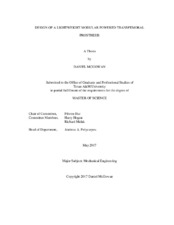| dc.description.abstract | Rehabilitation options for transfemoral amputees are limited, and no product today can mimic the full functionality of a human limb. Powered prosthetics have potential to close this gap but contain major drawbacks which ultimately increase the energy expenditure of the user. This thesis explores the viability of new designs and methods to reduce energy expenditure. In doing so a prototype containing many of the explored concepts is also being constructed to replace the laboratory’s current powered prosthetic, AMPRO II. This goal is accomplished by reducing weight through optimizing structural components, using lightweight motors and gearing, and reducing the energy requirements through novel passive spring sub-assemblies. Adjustable and modular components also enable a wider range of use and are explored. The main objective of this thesis is to investigate these design improvements and create the next-generation prosthetic for the Human Rehabilitation Lab.
This thesis explores using a combination of passive and powered components to reduce the need for heavy actuators. Methods involve coding walking simulations based on an inverse dynamics study. By simulating design concepts with elastic elements the resulting power requirements of the motors have been estimated to evaluate each concept. Motors and gearing options have also been investigated with an optimization-based approach; gearing ratio was minimized in a test comparing discrete off-the-shelf motor options to biomechanical requirements. For the structural components, the mass of each part has been minimized through an iterative approach in FEA.
Elements selected for further investigation from this thesis are being constructed with a prototype. Improvements over AMPRO II include adjustable height, functionality on both legs, a flexible foot, modularity, capabilities of passive elastic elements, and a mass estimated to be 20% lighter. Components include flat motors with harmonic drives, adjustable pylons for height, a low-profile mounting frame, passive pre-loaded springs, and a rotary series elastic actuator (RSEA). Unproven concepts such as the springs and RSEA have been designed as modular and optional to reduce risk. Moving forward, the first prototype is currently being built without the optional components to test the biomechanics. Future tests will incorporate the designed elastic elements to validate simulation concepts. | en |


